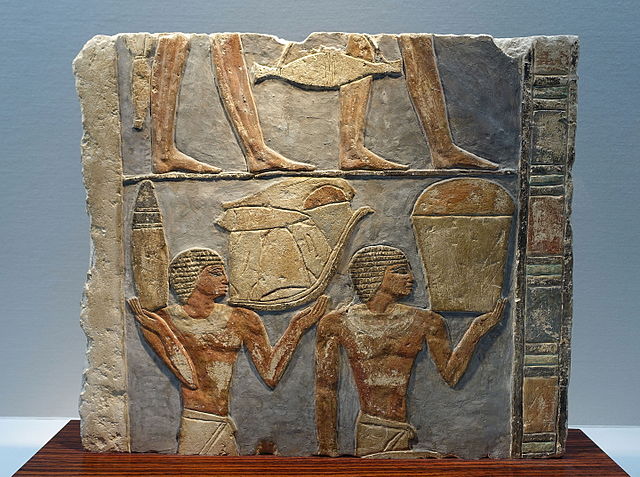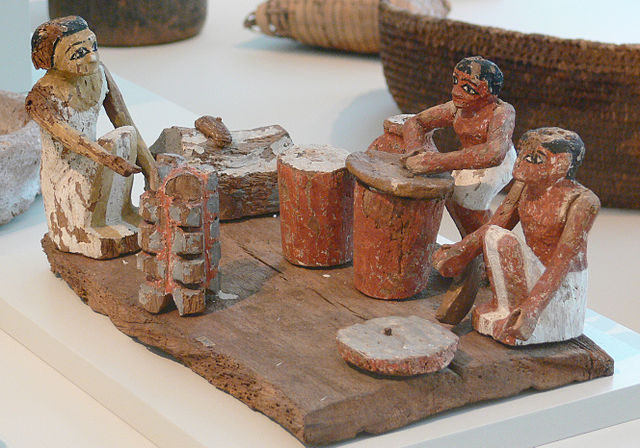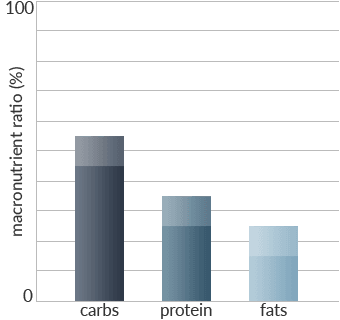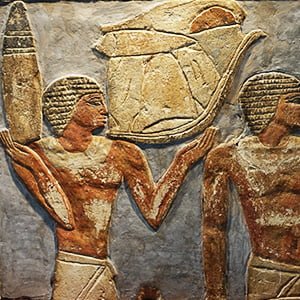
Nutrition in ancient Egypt centered around bread, beer, and vegetables. An abundance of barley and emmer wheat available to the Egyptians led to a diet heavy with many variations of bread and (nutritional) beer, while advances in domestic livestock and agriculture allowed for sufficient intake of plant and animal products.
Bread
Bread held significant cultural importance as it was an integral item within ancient Egyptian nutrition and was featured at almost every meal. Emmer, rich in protein, carbohydrates, and various vitamins, was nearly exclusively the only grain used in baking bread, though barley was sometimes used as well. These loaves of bread were sometimes flavored with herbs like cilantro, though they were likely typically eaten unseasoned among the poor.
Beer

While seemingly counterintuitive, ancient Egyptian beer was highly nutritious and was featured at almost every meal. One of the processes for making beer involved fermenting partially uncooked bread in a pot of water. This produced a fermented drink populated with barley solids, serving as an excellent source of protein and carbohydrates. This drink was perhaps nutritionally comparable to Greek kykeon, though kykeon was not always alcoholic.
Fruit and Vegetables
Next to bread and beer, plant products such as vegetables, fruit, and legumes were most common in the ancient Egyptian diet. Gourds, celery, onions, beans, and peas could all be cooked into a stew or served as a side dish. Archeological evidence suggests Egypt imported olive oil from Mesopotamia, though Egyptians often made their own oil from sesame, lettuce, and radish seeds. Popular sweet fruits included Pomegranates, grapes, dates, and figs.
Meat and Dairy

Ancient Egyptians had moderate access to meat and other animal products. Fish and domesticated cattle, pigs, sheep, and poultry all served as a good source of fats and proteins within Egyptian nutrition. The most common types of meat were likely pork and mutton, though beef was moderately available as well. Domestication of chickens around the 5th century BC provided a fair amount of poultry and eggs. Domestic cattle allowed for production of milk and butter for both cooking and consumption as well.
Ancient Egyptian Nutritional Analysis
 With regard to modern nutritional recommendations, the average ancient Egyptian citizen likely had an excellent diet. This diet consisted of substantial amounts of grains, followed by fairly heavy amounts of other plant products, including vegetables, legumes, and fruits, all in tandem with moderate consumption of meat and dairy. On average, this diet would provide desirable macronutrient ratios and supply sufficient micronutrients for the Egyptian citizen. With these things in mind, the average macronutrient ratios within ancient Egyptian nutrition were likely around 45-55% carbohydrates, 25-35% protein, and 15-25% fats.
With regard to modern nutritional recommendations, the average ancient Egyptian citizen likely had an excellent diet. This diet consisted of substantial amounts of grains, followed by fairly heavy amounts of other plant products, including vegetables, legumes, and fruits, all in tandem with moderate consumption of meat and dairy. On average, this diet would provide desirable macronutrient ratios and supply sufficient micronutrients for the Egyptian citizen. With these things in mind, the average macronutrient ratios within ancient Egyptian nutrition were likely around 45-55% carbohydrates, 25-35% protein, and 15-25% fats.
Ancient Egyptian Foods
Listed below are some foods that would have been commonly found in the ancient Egyptian’s diet, organized roughly by food group.
Grains
- Barley beer
- Emmer and barley bread
Fruit, Vegetables, and Legumes
- Celery
- Chick peas
- Figs
- Gourds
- Grapes
- Garlic
- Lentils
- Onions
- Pomegranates
- Radishes
- Raisins
Meat
- Beef
- Chicken and other fowl
- Fish
- Hedgehog
- Mutton
- Pork
Dairy, Eggs, and Oils
- Eggs: chicken
- Cheese
- Milk
- Olive oil
- Sesame oil
[raw_html_snippet id=”bib”]
Kemp, B. J. (2005). Ancient Egypt: Anatomy of a civilization, second edition. London: Routledge.
Nicholson, P. T., & Shaw, I. (2009). Ancient Egyptian materials and technology. Cambridge: Cambridge University Press.
Ensminger, A. H. (1994). Foods & nutrition encyclopedia. Boca Raton: CRC Press.
Bunson, M. (1991). The encyclopedia of ancient Egypt. New York: Facts on File Publications.
[raw_html_snippet id=”endbib”]
